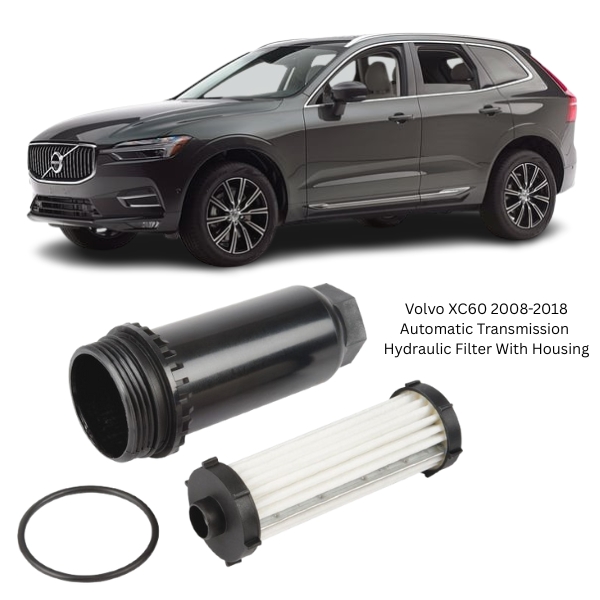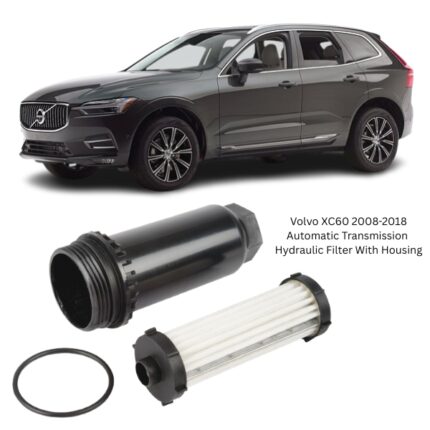Get Volvo XC60 2008-2018 Automatic Transmission Hydraulic Filter With Housing 2513A040 in Kenya
The Automatic Transmission Hydraulic Filter with Housing is a vital component in the transmission system of a vehicle, designed to ensure the smooth operation, durability, and reliability of the automatic gearbox. Its primary purpose is to filter out contaminants, debris, and impurities from the transmission fluid, thereby maintaining the quality of lubrication and hydraulic pressure inside the transmission. By keeping the transmission fluid clean, the filter with housing protects sensitive internal components such as valves, clutches, gears, and solenoids from premature wear and damage.
Unlike standard filters, this part comes as an integrated assembly – the filter itself along with its protective housing. This design enhances durability, ensures proper fitment, and simplifies the replacement process.
1. Role of the Transmission Filter
Automatic transmissions rely on hydraulic fluid to operate smoothly. This fluid not only lubricates moving parts but also acts as a cooling medium and a hydraulic agent to transfer power within the gearbox. Over time, tiny particles such as clutch material, metal shavings, dirt, and sludge can accumulate in the fluid. If left unfiltered, these contaminants can clog narrow oil passages, cause excessive friction, and lead to costly transmission failure.
The hydraulic filter is therefore tasked with:
-
Capturing and holding contaminants before they reach sensitive components.
-
Maintaining clean fluid circulation within the system.
-
Ensuring consistent hydraulic pressure for gear changes and torque converter function.
-
Prolonging the lifespan of transmission components.
2. Construction and Design
The Automatic Transmission Hydraulic Filter with Housing consists of two main sections:
-
Filter Element: The internal filtering medium is typically made of fine synthetic fiber, cellulose, or a combination of both. It is engineered to trap microscopic particles while allowing sufficient fluid flow.
-
Housing Assembly: A durable outer casing that holds the filter securely in place. The housing is often made from high-strength plastic or lightweight metal designed to resist heat, pressure, and exposure to transmission fluid.
Key design features include:
-
Sealing Mechanism: Rubber or silicone gaskets prevent leaks and ensure proper fluid flow through the filter.
-
Mesh Screens or Layers: For capturing larger particles before they reach the main filter media.
-
Outlet and Inlet Ports: Precisely engineered passages to allow controlled entry and exit of fluid.
This integrated design minimizes the risk of bypass leaks, improves durability, and ensures that all transmission fluid is properly filtered before reaching critical components.
3. Features of the Transmission Filter with Housing
High-quality hydraulic filter assemblies offer several notable features:
-
Efficient Filtration: Designed to capture both microscopic particles and larger debris.
-
Long Service Life: Built to withstand high operating pressures and temperatures.
-
Leak-Proof Housing: Prevents contamination bypass and fluid leakage.
-
OEM-Level Fitment: Manufactured to exact specifications for seamless installation.
-
Corrosion Resistance: Materials engineered to resist degradation from transmission fluid and heat.
-
Optimized Flow: Maintains consistent fluid circulation without restricting pressure.
4. Importance in the Transmission System
The role of this filter assembly cannot be overstated. It directly impacts:
-
Transmission Performance: Clean fluid ensures smooth gear changes and responsive performance.
-
Component Protection: Prevents premature wear of clutches, gears, bearings, and solenoids.
-
Fluid Longevity: Reduces contamination, extending the service life of the transmission fluid.
-
Cost Savings: Replacing a filter is far less expensive than repairing or rebuilding a damaged transmission.
5. Signs the Transmission Filter Needs Replacement
Over time, even the best filter reaches capacity and must be replaced. Common signs include:
-
Slipping Gears: Dirty fluid restricts hydraulic pressure, leading to delayed or slipping shifts.
-
Shuddering or Hesitation: Contaminants in the fluid affect smooth operation.
-
Unusual Noises: Whining or grinding noises from the gearbox may indicate fluid starvation.
-
Overheating Transmission: Restricted fluid flow leads to poor cooling and higher operating temperatures.
-
Dirty Fluid Appearance: Fluid turns dark, gritty, or develops a burnt odor.
-
Warning Lights: Some vehicles trigger a transmission fault light when fluid flow is compromised.
6. Maintenance and Service Intervals
Transmission filters, along with the fluid, should be inspected and replaced at manufacturer-recommended intervals. While intervals vary by vehicle and driving conditions, replacement is often advised every 40,000 to 80,000 kilometers. Heavy-duty use such as towing, frequent stop-and-go driving, or operating in extreme conditions may require more frequent servicing.
When replacing the filter:
-
Always replace it with a complete kit that includes the filter, housing, gaskets, and seals.
-
Ensure the transmission pan and magnets are cleaned of accumulated sludge.
-
Refill with the correct type and amount of transmission fluid.
7. Installation Considerations
Replacing an automatic transmission hydraulic filter requires technical precision:
-
Vehicle Preparation: Lift and secure the vehicle safely.
-
Drain Transmission Fluid: Remove the transmission pan and drain the old fluid.
-
Remove Old Filter and Housing: Unbolt or unclip the old assembly carefully.
-
Inspect Components: Check the transmission pan, gaskets, and surrounding components for wear.
-
Install New Filter Assembly: Fit the new filter with housing securely, ensuring seals and gaskets are properly aligned.
-
Refill Transmission Fluid: Add the recommended fluid type and amount.
-
Test Drive: Verify smooth shifting and check for leaks.
Professional installation is highly recommended due to the complexity of automatic transmissions.
8. Advantages of Using a Complete Filter with Housing
Compared to standalone filters, an integrated filter with housing offers several benefits:
-
Improved Sealing: Reduces chances of leaks.
-
Stronger Protection: More robust construction against heat and pressure.
-
Ease of Replacement: Housing simplifies installation and ensures correct positioning.
-
Better Durability: Designed for long service intervals without compromising performance.
9. Safety and Reliability
Since automatic transmissions are intricate and expensive, ensuring clean fluid is crucial. A compromised filter can lead to transmission failure, which is one of the most costly repairs a vehicle owner can face. Using a reliable filter with housing ensures long-term safety, vehicle reliability, and optimal performance on the road.
Follow us on Facebook for more parts.





Reviews
Clear filtersThere are no reviews yet.